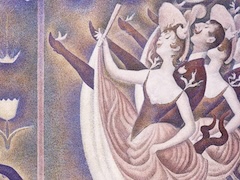Gray Weather, Grande Jatte by Georges Seurat

Gray weather intrigued many landscape painters who wished to explore the effects of a light that does not produce strong shadows or bleach what it strikes. The Parisian basin is characterized by a moist gray light which Monet especially loved; he had earlier painted along the shores of La Grande Jatte. Here, against the evanescent grays of sky and water, Georges Seurat placed a rich chromatic array. The sandy strand in the foreground consists of lavenders, pinks, tans, orange-tans, and blues over larger buff-colored strokes, resulting in no single hue but in a mixed tone between ruddy brown and tan. The foliage at the upper left, despite its relative darkness, is a dazzling mixture of intense medium blues, several strong greens, some lavenders, orange yellows, and oranges. The leaves at the center top and right, closer to us and perhaps from a different species of tree, have little of the intense blue and instead show wine reds and darker greens.
Gray Weather, Grande Jatte is virtually a pendant of Bridge at Courbevoie. Despite its gray light, it has a richer color than the other canvas. It is less austere and closer to the work of Corot and Monet, not only because it lacks the insistent verticals of Le Pont but also because its foreground is more varied along the water and the foliage of its framing trees takes the form of sheltering arabesques. It lacks the spectators, the fisherman, the bridge, and the factory chimney, all of which give the other picture its marks of activity. We face instead the red-roofed residences of Courbevoie or Asnières from the vantage point of a quieter mooring. The principal boat is a small steamer named "la Felicite" according to Maximilien Luce, more likely a pleasure boat than a commercial one. To the left protrude the bows of riverboats, like two pikes; they bear the red, white, and blue pennants of a rental agency or boat club. Along these well-manicured shores, the boats lend a quiet expectancy to the calm day.
















